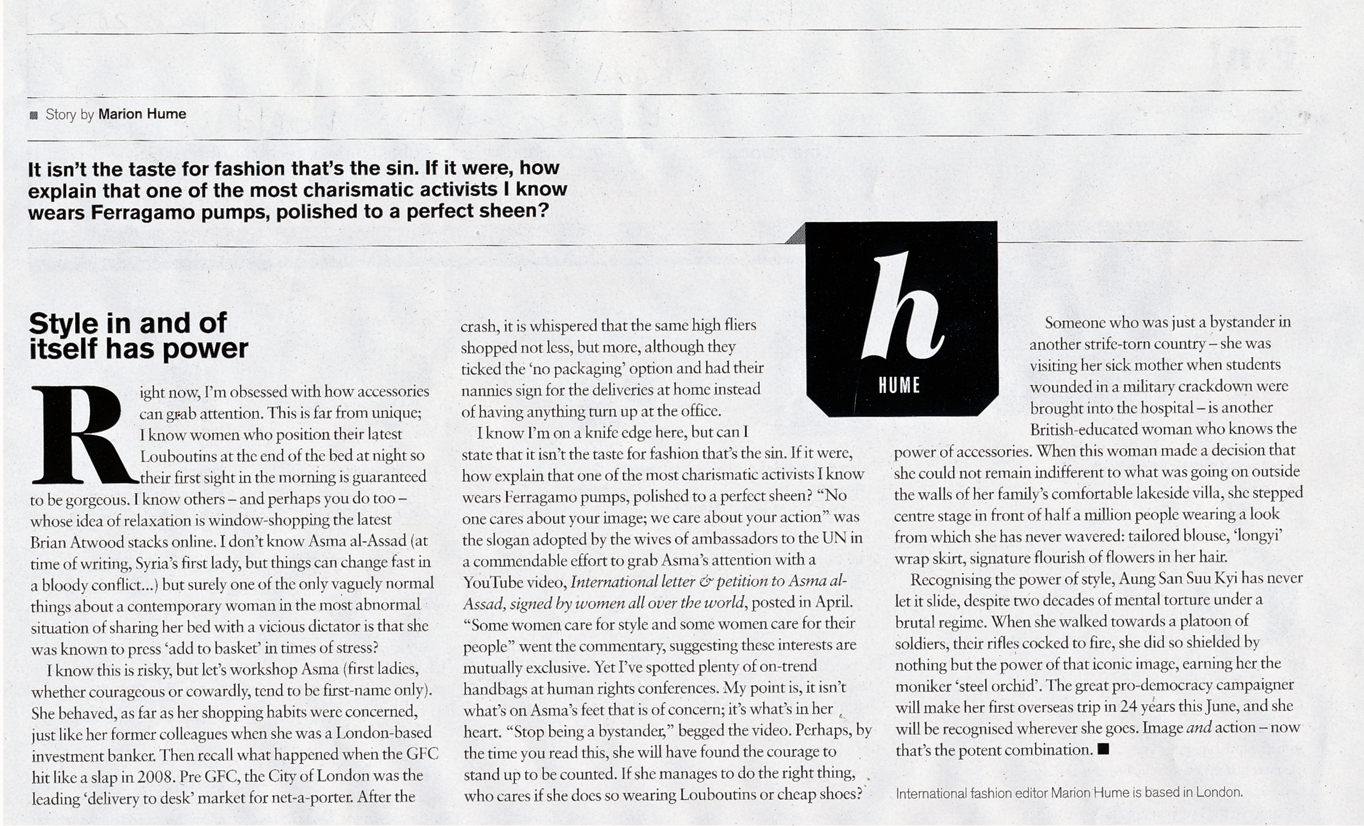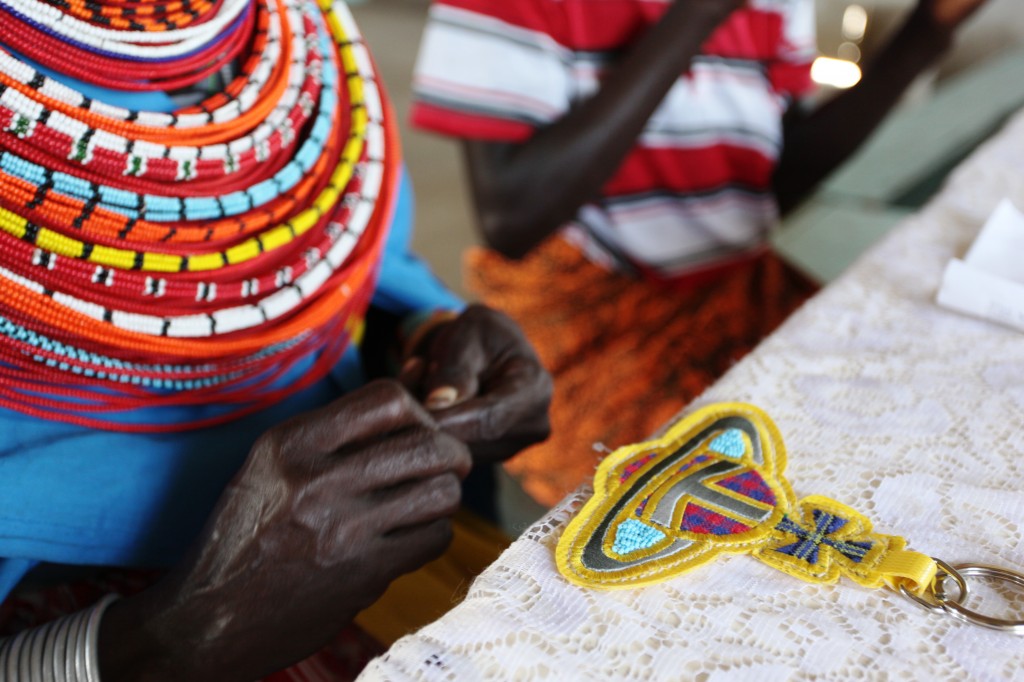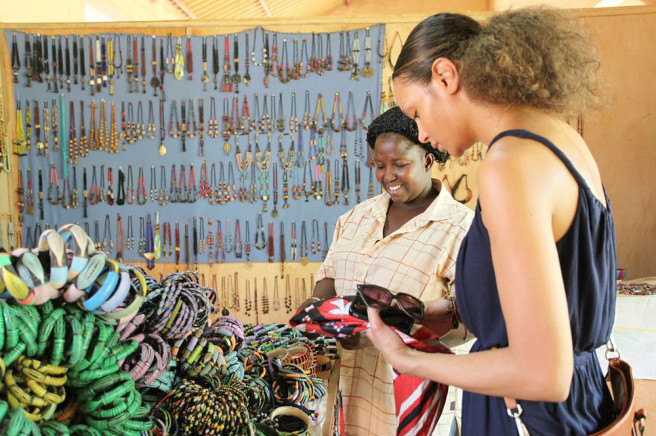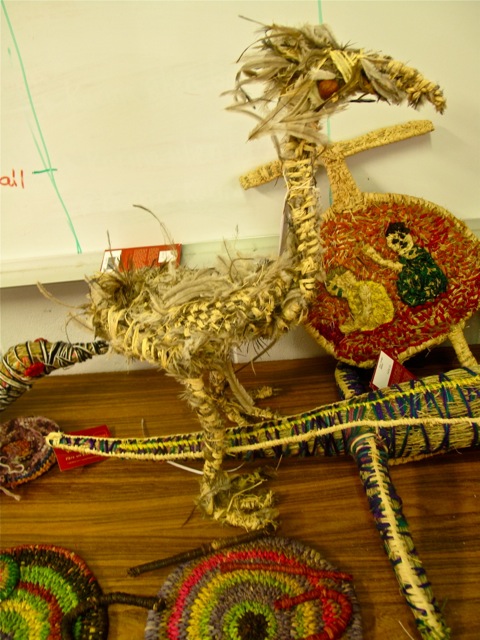Category Archives: Ethical Fashion
Fashion Hearts Kenya? – The Business of Fashion
How has the recent terror attack on Westgate Mall in Nairobi changed things for designers with manufacturing connections in Kenya? Marion Hume reports.
Business of Fashion | October 2013
NAIROBI, Kenya — Bex Manners, aka Bex Rox — which is the name of her costume jewellery line — figured it would be sensible to sit down for a proper brunch. A long working day lay ahead, then the midnight flight back to London. But time was pressed. So instead she grabbed take-out from ArtCaffe and went on her way. Less than 15 minutes later, terrorists stormed the Westgate Mall. The four-day siege in Nairobi left at least 67 dead, 39 still missing, a nation reeling.
You might be surprised who in the fashion world has ties to Kenya. Bex Rox is known for rock and roll, party-all-night-in-Ibiza edginess, not “ethical” or “Africa.” A connection to the continent happened by chance. She was in London’s Portobello Road, bumped into Cristina Cisilino (of the high-end jewellery producer, Crea Africa, based in Nairobi) “and the next thing I knew, I had a 40-piece collection being prototyped and I flew out to [Kenya] to see samples through the final stages.”
A Paris fashion week party to show off “Afrika” — including bold bracelets in gold-plated brass and knuckleduster rings in sock-it-to-you brights — went ahead as planned. Yet as guests sipped cocktails and took in the view of the Eiffel Tower from the private residence, on loan for the night, talk turned to near-misses. “The first thought was, ‘Are our friends safe?’” said Erin Beatty, design director of Suno and veteran of the New York-to-Nairobi commute. “Common sense told all of us not to go to Westgate,” said a subdued Max Osterweis, founder of Suno, the label named after his mother, who has had a home on the Kenyan island of Lamu since his childhood. “But when you need something for your laptop, it’s where the Apple store is. It’s where the book store is; the ATM.”So what now?
Does fashion “heart” Kenya?
Does fashion care?
“I can say our customers have been buying a lot,” says a still-shaken Manners. “Is that because of what just happened? Honestly, no. It’s because it’s handmade, lovely and I can cater exclusively for small quantities; I can offer an amazing colour palate with the Maasai beading.”
Osterweis is of the opinion that caring can never come first in fashion, this despite founding Suno because he cared so much. The son of a wealthy family, he launched Suno instead of writing a bit fat charity cheque after Kenya’s post-election violence, in 2008, claimed over a thousand lives and left 350,000 people displaced. As he told me when we met in Nairobi for a Time magazine story (April 2009), “I wanted to set an example to show that investment in Africa need not be about building more safari lodges.” An entirely “made in Africa” label was never the ambition however. “I’d seen brands being unrealistic, so we’ve invested in people’s strengths, produced what we knew could be done well in Kenya, while also producing elsewhere,” he told me then, revealing his aim to dress cool girls for hot, New York-summer nights, while, at the same time, providing work to skilled Kenyan artisans (as well as those in Italy and the United States).
Today, fans of Suno include the actress Elle Fanning, the artist Cindy Sherman and American First Lady, Michelle Obama. And as the label has soared, so too have the number of units made in Osterweis’ second home nation, bolstered by an additional online offering of sneakers, pyjamas and totes made exclusively in Kenya. “No one has said ‘I’ll order more,’” he says now. “People buy what they like.” As for his commute, “Nothing changes, except we won’t be eating pizza at Artcaffe. What happened is not a Kenyan problem, it’s a global problem. It’s not life as usual. It’s dealing with life as it is.”
Because it was founded by Bono and his wife Ali Hewson, Edun attracted first ludicrous expectations then harsh criticism, especially after pragmatic, LVMH-appointed CEO Janice Sullivan insisted on scaling African production back to ensure a viable economic foundation for the brand. (“Out of Africa, Into Asia” was how The Wall Street Journal reported the decision, back in 2010). Sullivan’s tactic to pull back, shore up, then reintroduce the African production that was Edun’s central “raison d’etre” seems to be working at last. Over 80 percent of the line is now made on the African continent, although the percentage in Kenya, where it all began, remains quite small.
“No one has brought up Kenya once,” says Sullivan at Edun’s Paris showroom, this while fingering a goat horn and silver collar, made in collaboration with Nairobi-based jeweller, Penny Winter. Instead, she says, the chatter is about the brand’s new designer, Daniela Sherman (formerly of Alexander Wang and The Row). So will Edun stick with Kenya, especially given growing production in Madagascar means the brand could easily pull out of a trouble spot and still hit its “made in Africa” targets? Ali Hewson, who has joined us, looks incredulous at the suggestion. “We were in Kenya for the riots of 2008. We were in Uganda for the attack at the World Cup. We were in Mali two weeks before the coup. We’re Irish!” by which she means proximity to risk won’t change a thing.
Ilari Venturini Fendi admits to being nervous in Nairobi, “constantly aware of the possibility that something so bad might happen. It’s always been quite complicated to work in Kenya.” Whether she returns soon or not, there’s no question that her socially conscious, made in Africa accessories brand, Carmina Campus, will continue to operate in the country, where the facility to achieve the label’s ethical goals at the high quality expected by a Fendi is already established. Each season, artisans in Italy connect with those living in the slums of Korogocho and Kibera via video which, Venturini insists, is not about “us” teaching “them,” but instead an exchange of ideas and know-how.
Chan Luu’s seed bead wrap bracelets in raw-cut leather are hot sellers. Do global stores care that the Los Angeles-based celebrity jeweller produces in Kenya (where she may be the largest single contractor of Maasai beaders, all paid a fair wage)? “What matters is everyone buys!” she shouts across the melee of those placing wholesale orders at a showroom in Paris. In a quieter moment, she adds, “I believe poverty can create violence. My customers want to do good for the world, so they support these ethical fashion projects.”
Both Luu and Venturini Fendi were introduced to Kenya via The United Nations’ ITC Ethical Fashion Initiative, (full disclosure: it was on assignment in Kenya for Time that I met the head of the initiative, Simone Cipriani, and, as a result, began working with them). “The terrorist attack has produced a double effect,” Cipriani says. “Yes, short-term travel plans of colleagues in the fashion industry have been disrupted. First of all, we work to keep collaborations with us stable, supplying African artisans with ongoing work in a meaningful way. Another important reaction is from fashion brands wanting to bring work to Kenya (several more brands have reached out since the Westgate siege). Terrorism is a global threat. A way to fight is by giving work and dignity to every human being. And if we do it, by creating beautiful, unique and gorgeous products, so much the better for everybody.”
Surely eternal activist and ethical pioneer, Vivienne Westwood would agree? Did she include so many Kenyan bags in her Paris show this season out of solidarity with artisans she met when she visited Nairobi in 2011? “They’re my favourite bags, that’s why I show them,” says ever-honest Dame Viv backstage. “I show them because they’re lovely.”
Fashion’s New Stella – The Business of fashion
Fashion’s New Stella
With Milan Fashion Week in need of fresh blood, Giorgio Armani has invited emerging Italian designer Stella Jean to present her ethical Spring/Summer 2014 collection at the Teatro Armani, his Via Bergognone show space.
Business Of Fashion | September 2013
MILAN, Italy — In a business of first names — like Miuccia, Raf, Dries, Alber — things are about to get complicated. Meet fashion’s future star, Stella. That would be Stella Jean, who no less than Giorgio Armani has anointed a fashion supernova. Taylor Tomasi Hill, social media star and creative director of Moda Operandi, is another supporter. So is Natalie Kingham, head of fashion at Matches Fashion.
During Milan Fashion Week, Stella Jean — a resident of Rome — is set to show at the 550-seat Teatro Armani, the first womenswear designer so honoured, other than the emperor himself.
The show is scheduled to start at 10.30am start on Saturday, September 21st, which, while sandwiched nicely in the calendar between Emporio Armani on Friday and Giorgio Armani on Monday, pits it against a considerable challenger. Saturday morning during Milan Fashion Week is, you see, the sacred time for “shoe appointments,” a euphemism for shopping. Yet the buzz around “the new Stella” is such that the front-row set are confirming attendance in Via Bergognone rather than Via Monte Napoleone.
So why Stella Jean?
Firstly, she isn’t a baby designer. Rather, she is a woman of 34, mother of two and a former model (although she disliked all but the fittings and watching the designers at work). She launched her eponymous label in Rome in 2011, but far from being an overnight success, she twice failed to even qualify for the talent competition “Who Is On Next,” supported by Vogue Italia as part of the Alta Roma schedule. It was third-time luck when she finally qualified, then won.
Alta Roma’s elegant talent scout Simonetta Gianfelici helped to turn things around for Stella Jean, advising her to “be more sincere; do something that belongs only to you.” Stella Jean (her surname, though she doesn’t use it professionally, is Novarino) is half-Italian and half-Haitian. “I had struggled to find my identity,” she says. “I found it through my work. I put my two worlds together and found fashion was looking for that.”
She calls her unique vision “Wax & Stripes” — the latter for a father who hailed from industrial Turin and the former “for the black side of me, the black roots of the Caribbean islands.”
Certainly, the first thing that attracts the eye to Stella Jean’s work is her vivid use of colour and riotous prints; these in contrast to somber stripes and silhouettes so proper, they’d suit Vivien Leigh in The Roman Spring of Mrs Stone.
Here the story veers off into the history of “wax,” vibrant cotton prints worn across West Africa. Their original roots lie in Java, however, in the batik the Dutch transported, first back home, then to the Netherland Antilles in the Caribbean and thence to Africa with Helmond, Holland-based textile giant Vlisco, the dominant wax trader from 1846 to this day. “We think wax comes from West Africa. The slaves sent to the Caribbean islands came from West Africa. Yet wax is European, like me. No one ever believes I am Italian, but I am,” says Stella Jean.
Having witnessed her sophisticated global mash-up in a group show in Rome, last July, Suzy Menkes became an ardent champion of Stella Jean. And rumour has it that it was she who whispered in Armani’s right ear as Vogue Italia’s Franca Sozzani was whispering the same name in his left. Whatever the facts, the designer herself had no clue.
“I was on the expressway when a friend called and told me to pull over. Then I was screaming, ‘Is it for real?’”
Calmer now, she describes Armani’s offer as “a giant giving a hand to a new name. It’s not just for me. It is a symbolic act that gives hope to my generation.”
Mr Armani says he did it because “the new generation of Italian designers needs support. Stella-Jean will be the next designer to organise a fashion show at the Teatro Armani and I hope this experience brings her luck.” No word yet on whether he will be there to wish her that personally.
Matches Fashion will certainly be in attendance, having signed up Stella-Jean after a look book arrived, unheralded, at their London offices. “I was initially attracted to the styling which was exceptionally strong, as was her use of colour and print,” recalls Natalie Kingham, the company’s head of fashion. “When I looked at the collection up close the next time I was in Italy. Her clever mix of traditional fabrics in such modern shapes made me realise how interesting the label was. It felt relevant and really stood out. That it sells out the minute it hits the site is a sign that she has potential to be big.”
Taylor Tomasi Hill, Moda Operandi’s creative director, praises her Stella Jean’s “distinctive aesthetic — no small feat for an emerging designer. Her bold patterns tempered by ladylike silhouettes capture precisely how our customer wants to dress: unconventionally, but not at the expense of luxury or intelligent design.”
For myself, a fashion scribe of over 25 years, Stella’s first solo show, in Rome last January, stands among those rare debuts that feel right on target: John Galliano, Romeo Gigli, Phoebe Philo for Céline…. Yet bear with me here while I change hats, because (full disclosure) I also work as a consultant for the International Trade Centre’s (ITC) Ethical Fashion Initiative, a United Nations initiative aimed at changing the way the international fashion business works. The aforementioned Simonetta Gianfelici is a consultant too. And it was she who first recognised Stella Jean as the right creative collaborator for a collective of marginalised artisans far across the world.
Although the Ethical Fashion Initiative is active in Stella Jean’s mother country, Haiti, when she and Gianfelici found themselves wilting in 47-degree heat last April, it was not in Port-au-Prince, but Ouagadougou, in landlocked Burkina Faso, West Africa.
“Burkina Faso is rich in cotton and incredible weaving traditions. The poorest of the poor are the heirs to ancient artisanal traditions that can only be rejuvenated at the luxury level because handwoven fabrics are extremely labour-intensive,” explains Simone Cipriani, who helms the Ethical Fashion Initiative.
“Stella’s capacity to use materials from all over the world, along with her passion for involving people in a fair way in her supply chain — she is extremely serious about that — persuaded us to ask her to join with us.”
Cipriani’s delight when the news of Mr Armani’s support came through was at least as loud as Stella Jean’s. “It is something incredible!” he says now, still rather loudly.”That this work will be seen in the theatre of Armani!”
He will not be front row to witness it, however. He’ll be in Ouaga, where he will share the glory with the weavers of the collection, for whom a video of the event is being made.
Everyone agrees ethics can’t carry fashion. First, the design must be great. What ethics provide is “another positive dimension,” says Kingham.
“[Ethics] resonates, not only with our core values, but also our clientele,” says Tomasi Hill. “We’re passionate about representing ethically-minded designers who collaborate with artisans around the world.”
As for Stella Jean, “the world doesn’t need someone else to [just make] beautiful clothes,” she says. “We don’t need more empty aesthetic expressions. We have to grab a chance to do more, to tell more.”
“I come from two worlds and I believe the more we meld together, the stronger we can be.”
Dream Weavers – AUSTRALIAN FINANCIAL REVIEW
by Marion Hume
What constitutes fashion? That’s what I’m pondering while standing out in the Red Desert holding a handmade basket trimmed with emu feathers. Could it look good upended as a hat?
The Tjanpi Desert Weavers (pronounced “jumpy”, it means “grass”) make baskets – amazing, extraordinary, original baskets of fistfuls of spinifex. They embellish the baskets with skeins of vibrant wool, feathers and seeds. They also create toy animals in colours not seen in nature; but then I’m learning that the artisans of Australia’s Western Desert see nature in an entirely different way than I do.
I’m not a “clutter fan”, nor do I tend to buy souvenirs. Yet I find myself tempted by both the basket I want to put on my head, and what might or might not be a lizard. Maybe it’s a duck? The Tjanpi women make all sorts of animals, inspired by those that inhabitat a vast sweep of South Australia, WA and the Northern Territory, but also by those they have seen seen on television. A penguin, imagined in local grass, by an Indigenous woman living in one of the world’s most remote communities is a creature to behold.
The Tjampi ladies are spread across an area exceeding 350,000 square kms — bigger than Germany — yet they are both global and local. Their favourite material is raffia, which comes only from Madagascar, the island which hangs like a tear off the East Coast of Africa. This discovery reminds me why fashion is such a great beat. You and I speak one word of Malagasy (raffia) although perhaps unlike you, I’ve been to Antananarivo, that nation’s capital. There, 25 years ago, I met a real-life spiderman called Simon Peers, whose ambition was to rediscover the lost art of “milking” spiders to use the skeins to weave cloths of (natural) gold as had been done hundreds of years before. Last year, he achieved it with a dazzling drape exhibited at London’s V&A museum. (Every spider who contributed had been released at the end of each working day – none the worse, Peers believed – although we agreed, with aggressive hairy spiders, how could you tell?). Now, here I am, in the Red Centre of Australia, twiddling with a piece of raffia sticking out from a basket woven by an indigenous woman and recalling how half way across the world, on the island raffia hails from, the bizarre ambition of an eccentric Englishman lead to the creation of a thing of beauty and how with this basket/hat, another fashionable thing of beauty could be born.
Maybe one’s thoughts kangaroo-hop under the vast desert sky because the next thing I’m thinking is how complicated some of the names I have to learn to spell as a fashion reporter can be. Tjanpi is easy and with a lovely zing to it, however I have to check the website before I write here that the weavers are Ngaanyatjarra Pitjantjatjara Yankunytjatjara. I learn that their ancestors make circles of grass on which to balance whatever they needed to carry around on their heads, so I think there’s a millinery precedent.
I’ve come to Alice Springs to catch up with Krystal Perkins, who helms the Australian Indigenous Fashion Initiative, which launched at the AFR’s Bespoke last May and will celebrate indigenous creativity with a show in Sydney next April. Tjanpi hats? The challenge is, what with the heat, December to March, they may not be ready for the inaugural event. Yet even if we have to wait – and “wait lists” are, after all, very fashionable – with a few creative tweaks, we could be on to something.
I learn another new word; “Tjarpa!” “Put it on!”





